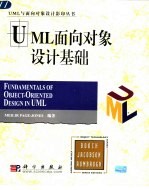图书介绍
UML面向对象设计基础【2025|PDF下载-Epub版本|mobi电子书|kindle百度云盘下载】

- (美)Meilir Page-Jones编著 著
- 出版社: 北京:科学出版社
- ISBN:7030114094
- 出版时间:2003
- 标注页数:458页
- 文件大小:35MB
- 文件页数:477页
- 主题词:面向对象语言,UML-程序设计-英文
PDF下载
下载说明
UML面向对象设计基础PDF格式电子书版下载
下载的文件为RAR压缩包。需要使用解压软件进行解压得到PDF格式图书。建议使用BT下载工具Free Download Manager进行下载,简称FDM(免费,没有广告,支持多平台)。本站资源全部打包为BT种子。所以需要使用专业的BT下载软件进行下载。如BitComet qBittorrent uTorrent等BT下载工具。迅雷目前由于本站不是热门资源。不推荐使用!后期资源热门了。安装了迅雷也可以迅雷进行下载!
(文件页数 要大于 标注页数,上中下等多册电子书除外)
注意:本站所有压缩包均有解压码: 点击下载压缩包解压工具
图书目录
Part Ⅰ Introduction1
Chapter 1 What Does It Mean to Be Object Oriented,Anyway?3
1.1 Encapsulation9
1.2 Information/Implementation Hiding12
1.3 State Retention14
1.4 Object Identity15
1.5 Messages19
1.5.1 Message structure19
1.5.2 Message arguments21
1.5.3 The roles of objects in messages23
1.5.4 Types of message25
1.6 Classes27
1.7 Inheritance33
1.8 Polymorphism38
1.9 Genericity43
1.10 Summary48
1.11 Exercises50
1.12 Answers52
Chapter 2 A Brief History of Object Orientation57
2.1 Where Did Object Orientation Come From?57
2.1.1 Larry Constantine58
2.1.2 O.-J.Dahl and K.Nygaard58
2.1.3 Alan Kay,Adele Goldberg,and others58
2.1.4 Edsger Dijkstra58
2.1.8 Bjarne Stroustrup59
2.1.7 Jean Ichbiah and others59
2.1.5 Barbara Liskov59
2.1.6 David Parnas59
2.1.9 Bertrand Meyer60
2.1.10 Grady Booch,Ivar Jacobson,and Jim Rumbaugh60
2.2 Object Orientation Comes of Age60
2.3 Object Orientation As an Engineering Discipline62
2.4 What's Object Orientation Good For?64
2.4.1 Analyzing users'requirements65
2.4.2 Designing software65
2.4.3 Constructing software66
2.4.4 Maintaining software69
2.4.5 Using software69
2.4.6 Managing software projects70
2.5 Summary73
2.6 Exercises75
2.7 Answers76
Part Ⅱ The Unified Modeling Language77
Chapter 3 Basic Expression of Classes,Attributes,andOperations85
3.1 The Class85
3.2 Attributes87
3.3 Operations89
3.4 Overloaded Operations92
3.5 Visibility of Attributes and Operations93
3.6 Class Attributes and Operations94
3.7 Abstract Operations and Classes95
3.8 The Utility97
3.9 Parameterized Classes98
3.10 Summary100
3.11 Exercises102
3.12 Answers103
Chapter 4 Class Diagrams107
4.1 The Generalization Construct108
4.1.1 Single inheritance108
4.1.2 Multiple inheritance110
4.1.3 Subclass partitioning110
4.1.4 Partitioning discriminators114
4.2 The Association Construct115
4.2.1 The basic UML notation for associations116
4.2.2 Associations depicted as classes119
4.2.3 Higher-order associations120
4.2.4 Navigability of associations122
4.3 Whole/Part Associations123
4.3.1 Composition123
4.3.2 Aggregation126
4.4 Summary130
4.5 Exercises131
4.6 Answers133
Chapter 5 Object-Interaction Diagrams137
5.1 The Collaboration Diagram138
5.1.1 Depicting a message139
5.1.2 Polymorphism in the collaboration diagram142
5.1.3 Iterated messages143
5.1.4 Use of self in messages144
5.2 The Sequence Diagram146
5.3 Asynchronous Messages and Concurrent Execution149
5.3.1 Depicting an asynchronous message149
5.3.2 The callback mechanism151
5.3.3 Asynchronous messages with priority155
5.3.4 Depicting a broadcast(nontargeted)message157
5.4 Summary159
5.5 Exercises161
5.6 Answers162
Chapter 6 State Diagrams164
6.1 Basic State Diagrams165
6.2 Nested States167
6.3 Concurrent States and Synchronization171
6.4 Transient States from Message-Result Arguments176
6.5 Continuously Variable Attributes178
6.6 Summary180
6.7 Exercises182
6.8 Answers184
Chapter 7 Architecture and Interface Diagrams188
7.1 Depicting System Architecture189
7.1.1 Packages189
7.1.2 Deployment diagrams for hardware artifacts191
7.1.3 Deployment diagrams for software constructs193
7.2.1 The window-layout diagram196
7.2 Depicting the Human Interface196
7.2.2 The window-navigation diagram198
7.2.3 A brief digression:What's object oriented about a GUI?200
7.3 Summary202
7.4 Exercises203
7.5 Answers204
Part Ⅲ The Principles of Object-Oriented Design207
Chapter 8 Encapsulation and Connascence209
8.1 Encapsulation Structure209
8.1.1 Levels of encapsulation210
8.1.2 Design criteria governing interacting levels of encapsulation212
8.2.1 Varieties of connascence214
8.2 Connascence214
8.2.2 Contranascence220
8.2.3 Connascence and encapsulation boundaries221
8.2.4 Connascence and maintainability222
8.2.5 Connascence abuses in object-oriented systems224
8.2.6 The term connascence227
8.3 Summary228
8.4 Exercises230
8.5 Answers231
Chapter 9 Domains,Encumbrance,and Cohesion233
9.1 Domains of Object Classes234
9.1.1 The foundation domain235
9.1.2 The architecture domain235
9.1.3 The business domain236
9.1.4 The application domain237
9.1.5 The source of classes in each domain238
9.2 Encumbrance241
9.2.1 What is encumbrance?241
9.2.2 The use of encumbrance244
9.2.3 The Law of Demeter244
9.3 Class Cohesion:A Class and Its Features246
9.3.1 Mixed-instance cohesion247
9.3.2 Mixed-domain cohesion248
9.3.3 Mixed-role cohesion250
9.4 Summary253
9.5 Exercises254
9.6 Answers255
Chapter 10 State-Space and Behavior259
10.1 State-Space and Behavior of a Class259
10.2 The State-Space of a Subclass263
10.3 The Behavior of a Subclass266
10.4 The Class Invariant as a Restriction on a State-Space267
10.5 Preconditions and Postconditions269
10.6 Summary272
10.7 Exercises273
10.8 Answers274
Chapter 11 Type Conformance and Closed Behavior278
11.1 Class versus Type279
11.2 The Principle of Type Conformance281
11.2.1 The principles of contravariance and covariance282
11.2.2 An example of contravariance and covariance283
11.2.3 A graphic illustration of contravariance and covariance288
11.2.4 A summary of the requirements for type conformance290
11.3 The Principle of Closed Behavior291
11.4 Summary294
11.5 Exercises295
11.6 Answers296
Chapter 12 The Perils of Inheritance and Polymorphism299
12.1 Abuses of Inheritance299
12.1.1 Mistaken aggregates300
12.1.2 Inverted hierarchy301
12.1.3 Confusing class and instance302
12.1.4 Misapplying is a306
12.2 The Danger of Polymorphism309
12.2.1 Polymorphism of operations309
12.2.2 Polymorphism of variables312
12.2.3 Polymorphism in messages314
12.2.4 Polymorphism and genericity316
12.3 Summary319
12.4 Exercises320
12.5 Answers322
Chapter 13 Techniques for Organizing Operations327
13.1 Mix-In Classes327
13.1.1 A business example328
13.1.2 Agraphics example333
13.2 Rings of Operations336
13.3 Summary342
13.4 Exercises343
13.5 Answers344
Chapter 14 Class Cohesion and Support of States andBehavior349
14.1 State Support in a Class Interface350
14.2 Behavior Support in a Class Interface352
14.3 Operation Cohesion in a Class Interface360
14.4 Summary364
14.5 Exercises366
14.5 Answers371
Chapter 15 Designing a Software Component377
15.1 What Is a Component?378
15.2 Similarities and Differences Between Components and Objects380
15.3 Example of a Component382
15.4 Internal Design of a Component389
15.5 Lightweight and Heavyweight Components397
15.6 Advantages and Disadvantages of Using Components400
15.7 Summary406
15.8 Exercises408
15.9 Answers409
Appendix A:Checklist for an Object-Oriented Design Walkthrough411
Appendix B:The Object-Oriented Design Owner's Manual417
Appendix C:The Blitz Guide to Object-Oriented Terminology423
Glossary425
Bibliography443
Index451
热门推荐
- 2986171.html
- 77587.html
- 3230683.html
- 1698019.html
- 1366079.html
- 1205744.html
- 1001775.html
- 2546159.html
- 2056730.html
- 1083779.html
- http://www.ickdjs.cc/book_3059904.html
- http://www.ickdjs.cc/book_1919208.html
- http://www.ickdjs.cc/book_1215428.html
- http://www.ickdjs.cc/book_3706969.html
- http://www.ickdjs.cc/book_3223725.html
- http://www.ickdjs.cc/book_3251730.html
- http://www.ickdjs.cc/book_1755353.html
- http://www.ickdjs.cc/book_1068578.html
- http://www.ickdjs.cc/book_2129216.html
- http://www.ickdjs.cc/book_2327996.html